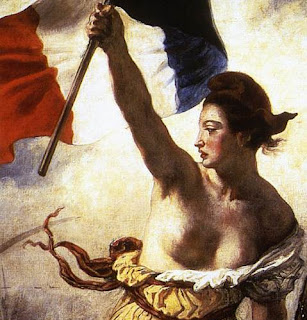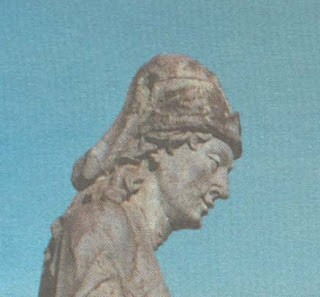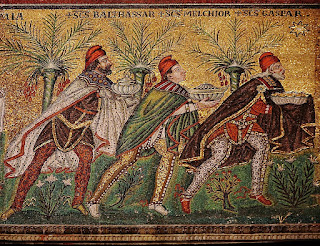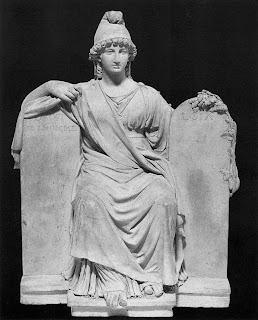Saturday, September 10th, 2011
Fragments of the Gates of Hell
For those of you who follow me on Twitter, you may have noticed I my tweets about Byzantine art over the past day or so. I’ve been revisiting Byzantine art this past week – it’s been quite a while since Justinian and I have hung out together. And I can always use more gold backgrounds in my life, right?
Today, while finishing up my Byzantine projects, I happened to notice some fun details in “anastasis” depictions that have caught my attention. ”Anastasis” is the Greek word for “resurrection.” Depictions of anastasis don’t reference the biblical story of Christ’s resurrection, but are inspired by the Gospel of Nicodemus (also called “Acts of Pilate”), an apocryphal text. These scenes show a triumphant, victorious Christ who has broken the Gates of Hell in order to rescue his Hebrew forbearers. Probably the best known anastasis painting is this one:

Anastasis, Funerary chapel of Theodore Metochites, located at the Monastery of Christ in Chora, 1310-1321
Here, Christ is shown rescuing Adam and Eve from their tombs. Other patriarchs, prophets, and kings wait on the sidelines – perhaps waiting their turn to be rescued by Christ. I like a lot of things in this painting, particularly that Christ and Adam are dressed in similar white robes. Since Christ was perceived as a “new Adam” to reverse the effects of the Fall, I think it’s fitting that they are depicted in matching clothes.
Anyhow, what I noticed today were details at the bottom of this wall painting. The Gates of Hell are depicted in reddish panels, located underneath Christ’s feet. In between the two gates is the defeated Satan, who is wrapped in a bundle. Underneath Christ’s feet there are a bunch of tiny fragments:

Anastasis, detail of funerary chapel of Theodore Metochites, located at the Monastery of Christ in Chora, 1310-1321
It turns out that these fragments are keys, nails, hinges, bolts, locks, and other tiny bits from the locks which sealed the Gates of Hell shut. Christ, in his triumph over death, has burst through the Gates of Hell with a dramatic gesture. From a historical standpoint, these different depictions are especially valuable to scholars and archaeologists. Some scholars have found that this fresco includes the most detailed depictions of keys, locks, etc., that exist and have compared the wall painting to actual historical artifacts.1
I decided to look at the Gospel of Nicodemus to see if there were any specific references to keys, locks, or the Gates of Hell. There are a few references, particularly Chapter V (XXI): 1-3. Christ announces his arrival at the doors, and Hell cries “unto his wicked ministers: Shut ye the hard gates of brass and put on them the bars of iron and withstand stoutly, lest we that hold captivity be taken captive” (Verse 1). The captive saints in Hell protest against this action, and King David reminds Hell that Christ is the individual who “hath broken the gates of brass and smitten the bars of iron in sunder” (Verse 2).
The artist for the funerary chapel of Theodore Metochites really took the “in sunder” description to heart! Other Byzantine artists also depicted this scene, but usually with less fragments of locks and keys. Here are three other anastasis scenes that include some keys and pieces of the “bars of iron.” I’m showing details of the images below, but also providing links in case anyone wants to see the full scene.

From the Anastasis, at Hosios Loukas, Greece
Detail of Anastasis, Russian icon from 17th century (Hermitage Museum). Detail image courtesy of jimforest via Flickr[/add_caption_link].

Detail of Anastasis, west vault from Cathedral of St. Mark, Venice, c. 1180
These artists have left the Gates of Hell in shambles – it’s no wonder anastasis scenes are sometimes called the “Harrowing of Hell!”2 If you know of any other anastasis scenes that have fun depictions of keys, locks, bolts, hinges and the like – please let me know!
1 George Fletcher Bass and James W. Allan, Serçe Limanı: An Eleventh-Century Shipwreck Vol. 2, (College Station, Texas: Texas A&M University Press, 2009), 449. Available online here.
2 If you want to be nitpicky, though, I think it’s more accurate to refer to Byzantine works of art as “anastasis.” The term “Harrowing of Hell” is an Old English and Middle English term, so it doesn’t perfectly apply to the Byzantine period.







